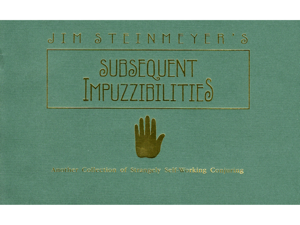 It's been a long time since the release of both Impuzzibilities and Further Impuzzibilities, but author Jim Steinmeyer has finally released the latest in the series, Subsequent Impuzzibilities. Is it a worthy successor to the previous two books? That's the topic of today's post.
It's been a long time since the release of both Impuzzibilities and Further Impuzzibilities, but author Jim Steinmeyer has finally released the latest in the series, Subsequent Impuzzibilities. Is it a worthy successor to the previous two books? That's the topic of today's post.
If you're not already familiar with the first books in the Impuzzibilities series, either go buy them now, or at least check out my 2006 review of both books. That way, at least we're starting at the same point.
Subsequent Impuzzibilities should be of interest to Grey Matters readers not only because it's about magic, but especially because the focus is on math-based self-working routines. Because of this focus, you can be amazed by performing the tricks as you read them. You can perform many of them over the phone, as well.
Before I get into the individual tricks, I'd like to mention that the psychology of each presentation is very finely crafted, and should be studied thoroughly as lessons in themselves. This shouldn't be surprising, since Jim Steinmeyer himself is the mind behind some of the greatest illusions and presentations of our time.
The book opens with “Eleven Roads to Heaven”, which is a great example of my point about the presentations. This 11-card routine involves repeating the same sequence of steps several times, which could quickly and easily become boring for the spectator. However, the ingenious presentation here of being able to pick out a face in a crowd the more you see it prevents the spectator's potential boredom.
In the previous book, Further Impuzzibilities, there was a trick called “Automatic Palmistry”, involving absolutely no props other than the spectator's hands. This book's “Fingertip Mindreading” is a good follow-up involving only the fingers of one of the spectator's hands.
One of the big hits of the original Impuzzibilities was the Nine Card Trick, which was popularized by no less than David Copperfield:
In Subsequent Impuzzibilities, continues examining the possibilities of this principle with “The Password Fallacy” and “A Universal Password”. In both of these routines, the routine is played as an example of the performer finding out the spectator's secret (a card name) as if they were hacking a password. I haven't seen this presentation used much in magic, yet it seems such an obvious match for many card location routines. This is where you start getting a sense for the genius of Jim Steinmeyer.
What the “Why didn't I think of that?” password approach is to presentation, the approach used in “Enigmatic Poker” and “Enigmatic Tarot” are to method. These tricks involve a somewhat unusual procedure involving the spectator telling you exactly how to shuffle, while the cards remain under much more control than it would seem. Even though they use exactly the same mixing procedure, their respective presentations justify the strange mixing in two different ways. Already I can see that this is the one thing from the book that will be adapted in myriad ways by magicians in the coming months.
Also written up earlier in the Impuzzibilities series is the “One O'Clock Mystery”, also popularized by David Copperfield:
In a similar vein, the newest book contains a number of similar effects in which several things are seemingly chosen at random, yet the outcome can be predicted in a myriad of amazing ways. “Number, Number, Number” and “A Trip Around the World” are longer routines with surprising punches, while “Force Six” and “Force Ten” are simple enough to print on your business card!
“Deal Three” is a great routine involving a different mixing procedure, this time done by the spectator. It almost seems to be a halfway point between the password routines and “Enigmatic Poker”. The person for whom you're performing can do this seemingly-fair mixing procedure as much as they want, yet you can still control the outcome. I can see this being very deceptive when mixed with the Free Will principle.
The remaining two routines from Subsequent Impuzzibilities I've saved for mentioning at the end because they both play big in their own way. “Ten in Concert” is a 3-phase routine in which the cards themselves repeatedly seem to know about the audience member's choices.
“The Magian Who Fools Himself” plays big because it can be done as a stage routine. All you need is someone from the audience, a deck of cards, a chair for the person to sit on, and something to hold the cards, such as a glass. In this effect, the spectator plays the part of the magician, and causes a card to vanish from one place and reappear in another. It's a re-working of the principle in “Teleportation”, and is an excellent lesson in why not to stop thinking about a routine.
Because these tricks are self-working, many may dismiss them. Not only will those who dismiss these tricks lose out on the presentations already there, but they won't see the potential of adapting these pieces to themselves. Also, there's nothing wrong with adding the occasional sleight or subtlety to improve them. David Copperfield's videos above are a good example of adapting and adding to routines like these.
In short, I recommend Subsequent Impuzzibilities highly, as well as all the Impuzzibilities books, not only for the tricks in the book, but for what you can learn about presentation, how to think about magic, and keeping things simple.
–––––––––––––––––––––––––––––––––––––––––––––––––––
Answer to Pi Day Magic 2 puzzle:
4C, 4D, KH, 9H - This arrangement could be used to cue the 6C.
0
Review: Subsequent Impuzzibilities
Published on Sunday, March 27, 2011 in books, fun, magic, math, products, reviews, videos
Related Posts
Subscribe to:
Post Comments (Atom)




No Response to "Review: Subsequent Impuzzibilities"
Post a Comment